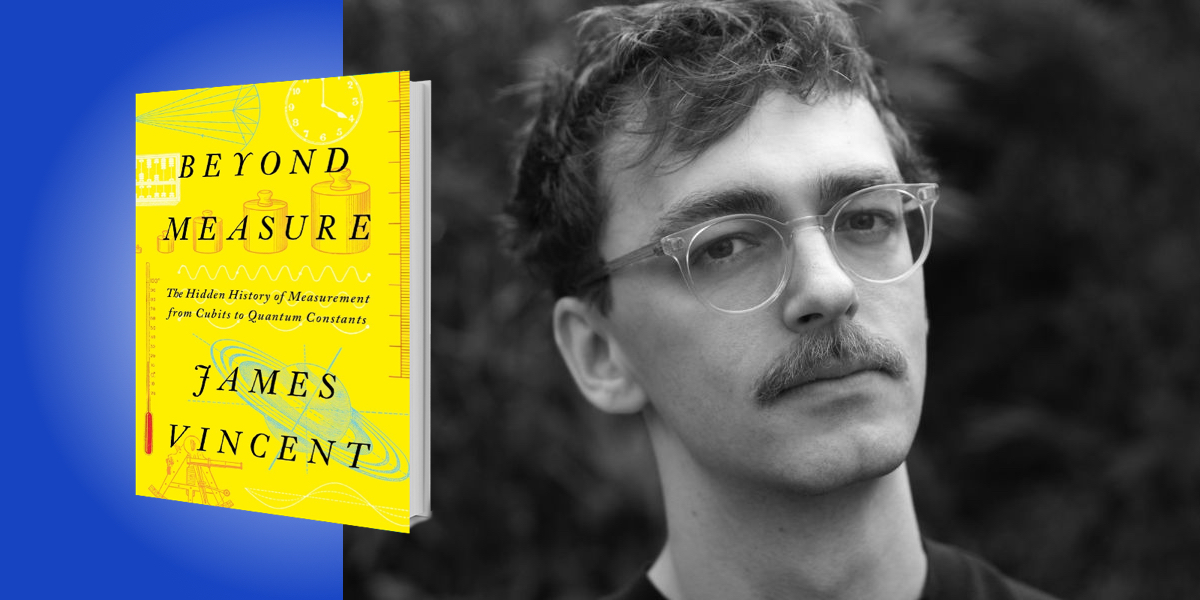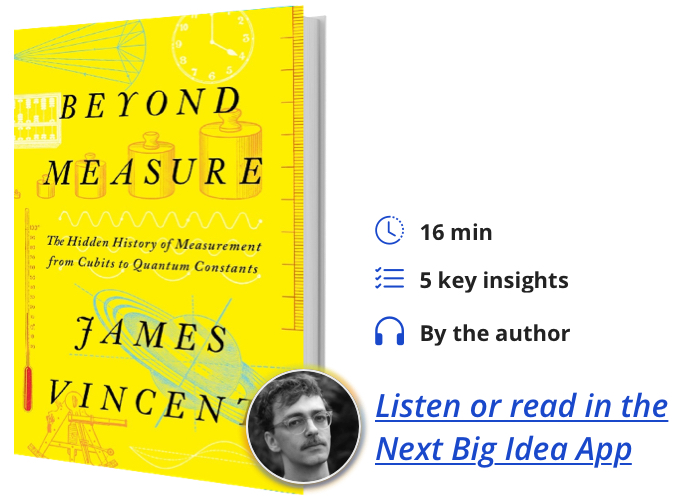James Vincent is a senior reporter for The Verge, the Vox Media site devoted to technology and society. He has also written for the London Review of Books, Financial Times, and Wired.
Below, James shares 5 key insights from his new book, Beyond Measure: The Hidden History of Measurement from Cubits to Quantum Constants. Listen to the audio version—read by James himself—in the Next Big Idea App.
1. Measurement is the kindling of civilization.
The science of measurement is as important to the development of human civilization as writing or mathematics. Without measurement, humans could not have easily traded goods, constructed cities, or collected taxes—activities that are fundamental to the development of complex societies. Without measurement, there would be no pyramids in Egypt, no Roman roads or aqueducts; there would be no empires of trade and certainly no scientific revolution. Measurement is not only vital to the coordination of human effort but is a sort of language: a tool for communicating over space and time to describe the world around us.
This lesson was hammered home for me when I visited Cairo to see an ancient, important, and obscure measuring device known as a nilometer. Nilometers were used by the ancient Egyptians to measure the depth of the Nile’s flood. They are essentially huge rulers, carved into the riverbank or constructed as free-standing columns, marked in cubits—the Egyptian unit of length, equal to the distance from the elbow to the fingertip.
The Nile’s annual flooding was the source of Egypt’s great wealth, covering the river’s banks with a fertile soil that provided an abundance of crops. However, the depth of these floods varied, and a few cubits of water could be the difference between a year of feast or famine. Nilometers helped tame this unpredictability. There were thought to be hundreds built around the country over the millennia, and their measurements helped set the agenda of the Egyptian state. If they showed low floodwaters, extra grain would be put aside to stave off hunger and riots. If they recorded high waters, then the state could rest easy.
These nilometers were so important that they were often built into temple complexes, where they would be consulted by Egypt’s hybrid caste of priest-civil-servants. Indeed, because the flooding of the Nile was thought to be divine—deified in the form of the god Hapi—the nilometers could be said to gauge not only the nation’s fortunes, but the will of the gods themselves. A ruler that measures the happiness of the gods shows the power of measurement for our ancestors.
2. Measurement is a reflection of our lives and our labor.
How do you define an acre? Today, you would measure out 4,047 square meters or 43,560 square feet. But in the Middle Ages the answer was both simpler and more complex: an acre was the amount of land that could be ploughed by a team of oxen in a single day.
Early units of measurement were often defined based on lived experience. They were taken from our bodies, nature, and work. In the modern world, measurement often seems abstract and disconnected from our lives, but ancient units remind us that measurement is deeply connected to our sense of the world.
“Units like these are inconsistent, but they have unique advantages, encoding information about peoples’ lives and the world around them.”
Most ancient societies have units of length derived from various body parts, like your foot or the distance between your outstretched hands. The Aztecs not only had units equivalent to the cubit and foot, but also the forearm alone; the tip of the hand to the armpit; the tip of the finger to the shoulder, and many more beside. Some of the units survive today, transmuted by centuries of use. The mile for example, was originally the Roman mille passus, which literally translates as “a thousand paces.”
Other units of distance are literal in definition, though with stranger origins. An old Finnish unit of length is the peninkulma, which was originally measured as the distance at which a dog’s bark could be heard. Or, as another example, the Saami people of Northern Europe have a unit known as the poronkusema—which literally translates as “reindeer’s piss,” and is supposedly equal to the distance a reindeer can walk before urinating. If you’re curious, that’s around 6 miles.
Units like these are inconsistent, but they have unique advantages, encoding information about peoples’ lives and the world around them. Consider the old Irish unit of the collop, which is defined as the amount of land needed to graze a single cow. That means a collop of lush pasture is going to be much smaller than a collop of barren hillside. It’s a unit that adapts to the landscape it measures, capturing information relevant to the people who use it. As one character in the 1942 Irish novel, The Tailor and Antsy, comments: “An acre might be an acre of rock but you know where you are with a collop.”
3. The metric system changed the world forever.
The historian Eric Hobsbawm once commented that, “the most last¬ing and universal consequence of the French revolution is the metric system.” It sounds like a joke, but there’s more than a little truth to this statement. The political ideals developed during the French revolution have obviously affected the course of history, but only the metric system, created during that same tumultuous period, has been embraced universally, regardless of creed.
The metric system was a political project as much as a scientific one, intended to replace the inconsistent units of the past with measures that were equal for all—a reflection of the revolution’s political ideals.
Prior to the revolution, France badly needed metrological reform. By one estimate the country was home to more than 1,000 recognizable units with more than 250,000 local variants. The most common measure of cloth, for example, the aune, could refer to one of 17 national variations. This created confusion, hampered the economy, and made it easy for the aristocracy to exploit commoners. One common trick was for local lords to collect tax payments of grain using units that were much larger than those used by peasants in the markets. As a common revolutionary slogan put it, the people wanted “one king, one law, one weight, and one measure.”
“Instead of measures derived from the authority of the monarch, the revolutionaries turned to an impartial arbiter and humanity’s shared heritage: measures derived from the Earth itself.”
The metric system was designed to solve these problems, defining its units using cutting edge science that replaced the old systems of power. Take the unit of length, the meter. This was defined by French scientists as one ten-millionth of the distance from the north pole to the equator and replaced the unit of pied du Roi—literally the “king’s foot.” Instead of measures derived from the authority of the monarch, the revolutionaries turned to an impartial arbiter and humanity’s shared heritage: measures derived from the Earth itself.
This unique approach to measurement helped spread the metric system across the globe. In the centuries since its creation, it has been adopted by just about every country. There are few nations, like the UK, that retain old units in odd places, but only three are called non-metric—Myanmar, Liberia, and the United States.
However, this isn’t the whole truth. For although the U.S. retains old measures like the pound and foot, these units have been defined using metric standards since 1893. The U.S. may boast about its resistance to metrication, but in their labs and factories, its units bow to the revolutionary might of metric.
4. Measurement is deeply cultural.
Here’s an unexpected consequence of the metric system: Brexit. This is mostly a joke, but not completely. Consider this: when the UK tried introducing metric units in line with EU regulations, a number of market traders were prosecuted for selling goods in pounds and ounces. They were dubbed the metric martyrs by the press and their case became a cause célèbre for skeptics of the EU, generating a huge amount of attention for groups like United Kingdom Independence Party (UKIP) and political figures like Nigel Farage.
Brexit had more causes, of course, but metrication was an important battleground. One BBC journalist described the prosecution of the metric martyrs as an event that, “helped turn public opinion against EU membership, giving critics some¬thing tangible to point to that affected people’s everyday lives and for which Brussels appeared responsible.”
Measurement is deeply embedded in our culture, and strongly associated with political sovereignty. Wars have not been fought over measurement, but the right to define a country’s weights and measures is often won or lost in these struggles. When Napoleon conquered Europe, he imposed metric measures at the point of a bayonet. Today, metric units are seen as a foreign threat to many in the U.S. and UK.
I found out firsthand how important measures are to some people when I hung around an anti-metric organization known as ARM, or Active Resistance to Metrication—a group of metrological guerillas who carry out raids across the UK, replacing metric signposts with those using Imperial measurements. They told me that units of measurement are cultural artifacts, part of an ancient heritage that we should not give up on easily. To some people this may sound silly, but I believe there’s some truth to this argument. After all, who in the UK would ever want to get rid of pints in pubs? Some measures are just too close to the heart to ever replace.
5. We’re obsessed with metrics—and it’s not always to our benefit.
Measurement has become one of the defining features of contemporary life: a discipline practiced at all levels of society and often presented as the only reliable method for progress. From school onwards our achievements are nothing unless they can be quantified and with the ubiquity of digital sensors, like smart watches, we are measuring ourselves more than ever before.
“Measurement has become a tool abstracted from human experience.”
Measurement is fundamental to structuring society, but from the 19th century onwards it became particularly embedded in all our lives. This is mostly due to the rise of managerial capitalism. Prior to this period, companies were usually controlled by individuals who had worked their way up through that specific industry: they were intimately familiar with the work and methods of production. Managerial capitalism involved the creation of a class of dedicated managers who needed new ways to judge the performance of their workers and workplaces.
To do this, they relied on ideologies like scientific management: the use of measurement to improve productivity. The inventor of scientific management, Frederick Winslow Taylor, broke down manual tasks into individual actions, measuring how long it took to perform each step in ideal conditions, before pushing workers to work in the most efficient manner. Here, you can see how measurement has become a tool abstracted from human experience.
In the 21st century, a belief in the importance of measurement has been strengthened by the rise of digital technologies that make tracking time and motion cheaper and easier. Perhaps the ultimate expression of this ideology today is the Amazon warehouse, where workers’ movements are tracked constantly, and individual tasks are timed to the second. Frederick Taylor and his stopwatch could only dream of such surveillance.
Often, our obsession with measurement means that we ignore the goal that the measures are designed to achieve. My own mother was an English teacher in a secondary school, and from her I first heard the phrase “you don’t fatten a pig by weighing it” —meaning that too much focus on testing meant that actual learning was left by the wayside. Measurement is fundamental to human flourishing, but we should never forget that measures are made to serve humanity, and not the other way around.
To listen to the audio version read by author James Vincent, download the Next Big Idea App today:
































